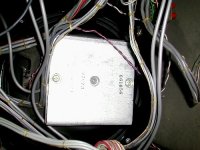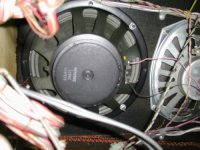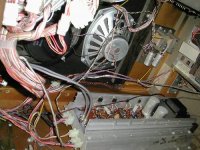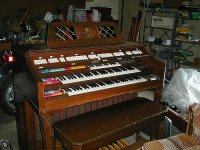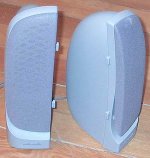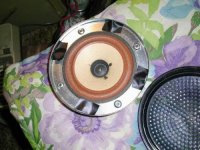Can anyone point me to some basic information on the effects of magnet size on driver performance and application?
Some things I noticed are...
Some things I noticed are...
- Older console systems and electronic organs with open back enclosure universally use small magnet drivers.
- Large magnets are suggested for horn enclosures.
- Have heard that small magnets require large enclosures.
- People equate small magnet with cheap.
[/list=1]
So I assume that large magnet = powerful motor (more force applied to the cone). How does this affect enclosure choices? Could a powerful motor also be designed using smaller magnet and larger coice coil? Are powerful motors required for horns due to the large acoustic load (resistance to cone movement)? When are small magnets preferred? How is magnet size related to efficiency?
I have also heard it said that large magnets improve midrange response rather than bass response. Is this true? If so it seems that a small magnet woofer could produce good results if crossed over at a low enough frequency.
I am interested in this topic as I have access to some older drivers of the old fashioned small magnet variety that I would like to use for some experiments in low power applications (infinite baffle, horn etc.) but I am not sufficiently familiar with the basics of these drivers to know where to start.
Thank you for your patience.
mike
Magnet size is a bit of a red herring. There are many different qualities of magnetic materials and it's possible for a monster cheap magnet to be totally outperformed by a high yield compact magnet. The magnet size is also influenced heavily by the voice coil as it has to accomodate the coil and former.
The magnetic flux and the number of turns on the voice coil will be one of the influences on sensitivity.
But, as a very broad brush stroke, a small magnet means a cheap speaker means high Qes and consequently high Qts.
The magnetic flux and the number of turns on the voice coil will be one of the influences on sensitivity.
But, as a very broad brush stroke, a small magnet means a cheap speaker means high Qes and consequently high Qts.
Thanks for the reply. Given the interaction of other parameters then I take it that in older speakers just looking at the size relative to modern designs doesn't tell us much.
So I guess my best bet is to try to measure the T-S parameters and proceed accordingly.
Would it be correct to assume that high Qts dictates infinite baffle and rather lower Qts indicates sealed or horn loaded enclosures in general?
mike
So I guess my best bet is to try to measure the T-S parameters and proceed accordingly.
Would it be correct to assume that high Qts dictates infinite baffle and rather lower Qts indicates sealed or horn loaded enclosures in general?
mike
Originally posted by richie00boy
Qts ... - 0.4 ish = OK for vented and horn and TL
Qts 0.3 ish - 0.5 ish = OK for sealed
Qts 0.5 ish - 0.8 ish = OK for infinite baffle
However with sealed or IB a Linkwitz Transform can be used to bring Q to a usable value.
Those confines are somewhat narrow... i've had many a vintage driver with Qs in excess of 1 that work just fine on an OB.
In a TL i'm usually looking for a driver with a Q between 0.35 & 0.7, in a horn less than 0.3, but higher Q drivers can be used to get a rising (anechoic) response in the bottom that helps obviate the need for BSC.
dave
Originally posted by richie00boy
But, as a very broad brush stroke, a small magnet means a cheap speaker means high Qes and consequently high Qts.
Don't let the size of the magnet deter you. Listen. I have been very surprised by old vintage speakers with diminuative magnets. They can really shine on an OB, or in a big IB or aperiodic box.
dave
More salvaged speakers
I just began looking into an electronic organ that I am salvaging and I found what looks like some really nice speakers. Since the organ has an open back (with grill cloth) I suppose there is no hope that the speakers would be useful for a horn sub but they do appear to be of fairly modern design with large magnet structures. The 12" would probably be good for an IB sub and the 10" and 6x9" could be used in a utility amp for my Korg Poly-six (once I finish repairing the NiCad leak ). There is even a Leslie in there that I could probably find some use for.
). There is even a Leslie in there that I could probably find some use for.
As a bonus there is a good sized two channel power amp in there. There is a lot of noise when the unit is powered on so the amp may need some repair but even if I can't repair it that big long heatsink will make a nice platform for a new amp.
Later I will go write down the numbers on the drivers and see if anyone has any information on their specifications.
The big speaker: Looks like 12".
I just began looking into an electronic organ that I am salvaging and I found what looks like some really nice speakers. Since the organ has an open back (with grill cloth) I suppose there is no hope that the speakers would be useful for a horn sub but they do appear to be of fairly modern design with large magnet structures. The 12" would probably be good for an IB sub and the 10" and 6x9" could be used in a utility amp for my Korg Poly-six (once I finish repairing the NiCad leak
As a bonus there is a good sized two channel power amp in there. There is a lot of noise when the unit is powered on so the amp may need some repair but even if I can't repair it that big long heatsink will make a nice platform for a new amp.
Later I will go write down the numbers on the drivers and see if anyone has any information on their specifications.
The big speaker: Looks like 12".
Attachments
Magnet size basics Post #1 Can anyone point me to some basic information on the effects of magnet size on driver performance and application?
-----------------------------------------------
(quote box doesnt work on my browser, sorry guys)
magnet size relates to compliance/suspension of the driver or the vas specification
which is used to design loudspeaker systems
-----------------------------------------------
(quote box doesnt work on my browser, sorry guys)
magnet size relates to compliance/suspension of the driver or the vas specification
which is used to design loudspeaker systems
Here are the numbers
Thanks Planet10. The donor organ is a Wurlitzer Centura Professional (full console 24 note pedal board) with Orbit III synth.
Each driver has three numbers printed on the magnet. The numbers as best I can read them in the dark garage are as follows.
Largest driver (I can't quite tell if it is a 12" or 15" until I get it out):
661056, 27273, 2207421
10" driver:
668459, 24651, 2857420
Oval driver:
651805, 21739, 2857407
Leslie driver:
661056, 27273, 2207421
As I was puttering about today I noticed that I have quite a few drivers laying around that I need to put to use. Besides the small magnet 12" organ drivers that I dropped in the JBL 902VX's when the original surrounds gave out I have...
Thanks Planet10. The donor organ is a Wurlitzer Centura Professional (full console 24 note pedal board) with Orbit III synth.
Each driver has three numbers printed on the magnet. The numbers as best I can read them in the dark garage are as follows.
Largest driver (I can't quite tell if it is a 12" or 15" until I get it out):
661056, 27273, 2207421
10" driver:
668459, 24651, 2857420
Oval driver:
651805, 21739, 2857407
Leslie driver:
661056, 27273, 2207421
As I was puttering about today I noticed that I have quite a few drivers laying around that I need to put to use. Besides the small magnet 12" organ drivers that I dropped in the JBL 902VX's when the original surrounds gave out I have...
- Two Radio Shack 12-1708 5.25" triax with heavy magnets
- Two Radio Shack 12-1848 5.25" Whizzer with heavy magnet
- One Radio Shack 40-1331 10" woofer with medium magnet.
- One Hitachi 4" plain jane small magnet.
- The above Wurlitzer drivers.
- Two Radio Shack soft dome tweeters.
- And finally two cheapo Polk computer speakers.
[/list=1]
Looks like I need to get to work huh?If anyone has numbers on those first three I could use that info too. I am thinking that the 1848s might do OK as horn loaded midranges or midbass horns. The 1331 seems like it might make a pretty decent sub in a sealed enclosure.
Some day (when I get set up to measure parameters) I might pull those 12's out of the JBLs and see if they might be useful in a custom speaker installation.
My listening room is right next to the garage so I could build in a pretty good sized horn or IB system without too much trouble (just need the money and time).
mike
The Donor Organ:
Attachments
Re: Here are the numbers
made by Jensen in 1974
made by Rola in 1974
brownish/yellow cone & a cyclops eye in the centre of the dome?
Are these the ones ranked among the worst computer speakers ever? I have a set of those downstairs.
dave]
Originally posted by mashaffer
Largest driver (I can't quite tell if it is a 12" or 15" until I get it out):
661056, 27273, 2207421
Leslie driver:
661056, 27273, 2207421
made by Jensen in 1974
10" driver:
668459, 24651, 2857420
Oval driver:
651805, 21739, 2857407
made by Rola in 1974
[*]Two Radio Shack 12-1848 5.25" Whizzer with heavy magnet
brownish/yellow cone & a cyclops eye in the centre of the dome?
[*]And finally two cheapo Polk computer speakers.
Are these the ones ranked among the worst computer speakers ever? I have a set of those downstairs.
dave]
Attachments
Originally posted by mashaffer
Here is a pic of the 1848.
Those are a Foster OEM (ie if a current model would be called a Fostex FE12x)... all 5 of mine have stiff surround syndrome. These should be really good, probably the best of the lot.
Do yours have stiff surrounds?
dave
Re: Fostex by Radio Shack...
Radio Shack never built anything themselves. The 40-1197 is a version of the FE103, the pod tweeter is a milled from billet Al Foster horn, and i have seen Coral & Panasonic OEM units as well... Stax even built them a set of ESL headphones (something to grab if you ever see them)
Now that i can measure T/S (new in FuzzMeasure 1.2) i'll dig these out and see what i get (there is no modern Fostex direct analog to these). I don't expect much bottom with the stiff surrounds, but i haven't found a cure yet that doesn't (counterintuitively) raise the Fs)
dave
Originally posted by mashaffer
there is a big surprise. Actually they do feel quite stiff. Do you think that the T-S params for the Fostex driver would be accurate for this version?
Radio Shack never built anything themselves. The 40-1197 is a version of the FE103, the pod tweeter is a milled from billet Al Foster horn, and i have seen Coral & Panasonic OEM units as well... Stax even built them a set of ESL headphones (something to grab if you ever see them)
Now that i can measure T/S (new in FuzzMeasure 1.2) i'll dig these out and see what i get (there is no modern Fostex direct analog to these). I don't expect much bottom with the stiff surrounds, but i haven't found a cure yet that doesn't (counterintuitively) raise the Fs)
dave
Sorry to hijack this thread, but do you know who did the speakers used in the Realistic (Radio Shack) Mach One speaker system ?
Product number for the system is 400-4029
Speaker Complement:
15" (38 cm) Acoustic suspension, 34.8 oz (986 g) magnet woofer with brass voice coil
1 extended range high compliance ferrofluid-cooled horn tweeter
Multicellular ferrofluid-cooled horn midrange speaker
Product number for the system is 400-4029
Speaker Complement:
15" (38 cm) Acoustic suspension, 34.8 oz (986 g) magnet woofer with brass voice coil
1 extended range high compliance ferrofluid-cooled horn tweeter
Multicellular ferrofluid-cooled horn midrange speaker
- Status
- This old topic is closed. If you want to reopen this topic, contact a moderator using the "Report Post" button.
- Home
- Loudspeakers
- Multi-Way
- Magnet size basics
